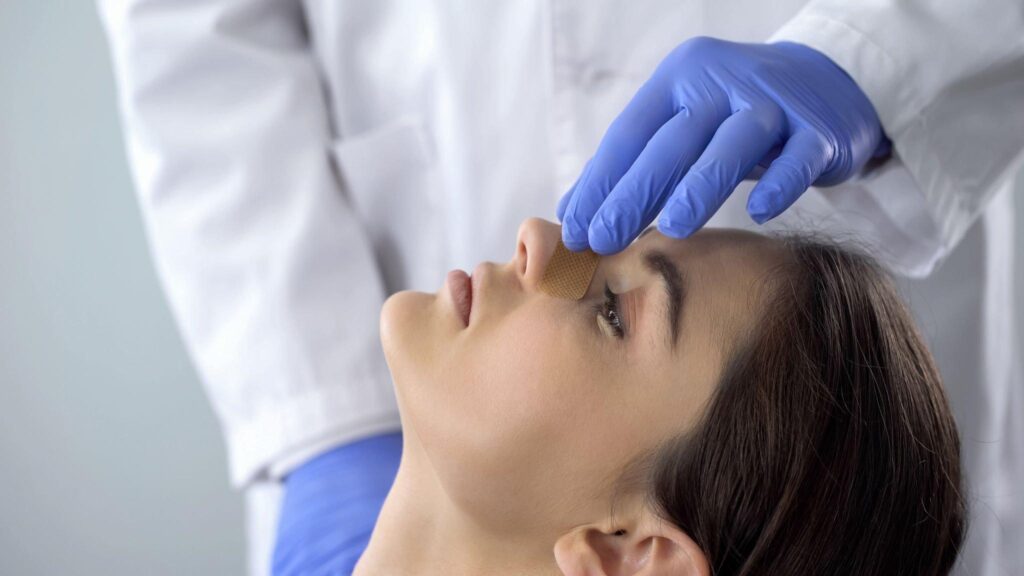Table of Content
- What is Rhinoplasty?
- Types of Rhinoplasty
- Rhinoplasty Procedure Steps?
- Benefits of Rhinoplasty
- Side Effects of Rhinoplasty
- Choosing a Surgeon For Nose Surgery in Delhi
Our nose size and shape play a very significant role in defining the overall appearance of the face. Nose reshaping surgery helps to make the nose appear better. Rhinoplasty surgery in Dwarka is one of the most popular to reshape your nose. This treatment can correct a broken or deviated septum nose.
Table of Contents
ToggleWhat is Rhinoplasty?
Rhinoplasty is a cosmetic surgery procedure that is also known as a “nose job”. This procedure is designed to enhance the appearance or functionality of the nose. Whether seeking to address aesthetic concerns or improve breathing, rhinoplasty has become widely performed.
Purpose of Rhinoplasty:
Rhinoplasty surgery in Delhi serves dual purposes. The first one is aesthetic improvement and the second is functional enhancement. People may opt for surgery to address problems like a prominent hump or a bulbous tip. Additionally, nose job (rhinoplasty) can be performed to correct breathing difficulties caused by structural abnormalities in the nasal passages.
Types of Rhinoplasty (Nose Job)
Nose surgery in Delhi encompasses various types tailored to people’s needs. Some of the common types of rhinoplasty include:
- Non-Surgical Rhinoplasty: It involves using injectable fillers to contour and reshape the nose without surgery.
- Reductive Rhinoplasty: This involves reducing nose size by reshaping cartilage and bone.
- Augmentative Rhinoplasty: This type of nose surgery focuses on enhancing the nasal structure.
- Post-Traumatic Rhinoplasty: This one addresses nasal deformities resulting from injuries, trauma, or accidents.
- Ethnic Rhinoplasty: This enhances the unique nasal characteristics of different ethnicities while achieving aesthetic goals.
- Functional Rhinoplasty: This aims to improve nasal functions, addressing issues like breathing difficulties, septum deviation, or sinus problems.
Each type of nose surgery in Delhi is personalized to the person’s anatomy, goal, and specific requirements. Consulting with a qualified surgeon is important for understanding the options and achieving desired outcomes.
Rhinoplasty Procedure Steps?
A nose job (Rhinoplasty) involves several key steps:
- Consultation: A thorough consultation with the plastic surgeon to discuss expectations, goals, and any potential risks.
- Anesthesia: The surgeon administers either general or local anesthesia to ensure you’re comfortable and pain-free during the procedure.
- Reshaping: The plastic surgeon reshapes the bone and cartilage either by adding, removing, or rearranging tissue to achieve the desired aesthetic or functional outcome.
- Recovery: After the treatment, you’ll be monitored as you wake up from anesthesia. You may experience swelling around the nose and eyes.
- Follow-up: Regular follow-up appointments are important to monitor your healing progress and ensure the desired results are achieved.
It’s crucial to note that rhinoplasty surgery in Delhi is a complex treatment and individual experiences may vary. Always consult with a qualified surgeon to discuss specific details and potential risks.
Benefits of Rhinoplasty
- Enhanced Facial Harmony: Rhinoplasty allows individuals to achieve a harmonious facial appearance by reshaping the nose to complement other facial features. Whether it’s reducing a dorsal hump or altering the nostril size, the surgery aims to create a more proportionate look.
- Improved Breathing Function: While rhinoplasty is often associated with cosmetic improvements, it also addresses functional issues that may impede proper breathing. Deviated septums or other structural abnormalities can be corrected during the procedure, leading to enhanced airflow and improved breathing.
- Boost in Self-Confidence: The psychological impact of rhinoplasty should not be overlooked. Many individuals who undergo the surgery report a significant boost in self-esteem and confidence. Feeling more satisfied with one’s appearance can positively influence various aspects of life, from personal relationships to professional endeavors.
- Correction of Birth Defects or Trauma: Rhinoplasty is not solely a cosmetic procedure; it is also utilized to correct congenital defects or injuries resulting from accidents. Whether someone is born with a nasal deformity or has suffered trauma that altered the nose’s shape, rhinoplasty can provide a reconstructive solution, improving both form and function.
- Long-lasting Results: One of the key benefits of rhinoplasty is that the results are generally long-lasting. Unlike temporary cosmetic procedures, a well-performed rhinoplasty can provide enduring improvements. This permanence adds to the overall satisfaction of individuals seeking a lasting transformation.
- Customized to Individual Needs: Rhinoplasty is a highly personalized procedure, with each surgery tailored to the specific needs and desires of the patient. Surgeons work closely with individuals to understand their goals, ensuring that the results align with their unique facial features and overall aesthetic preferences.
Side Effects of Rhinoplasty
- Swelling and Bruising: Common side effects include temporary swelling and bruising around the nose and eyes, which typically subside within a few weeks.
- Pain and Discomfort: Some discomfort is normal after the treatment, but pain is usually managed with prescribed medications during the initial recovery period.
- Nasal Congestion: Patients may experience nasal congestion due to swelling which is often used to support the new nasal structure.
- Scarring: While incisions are typically made inside the nostrils or inconspicuous areas, there may be some minimal scarring. Proper care and following postoperative instructions can help minimize scarring.
- Numbness: Temporary numbness around the surgical site is common and may persist for several weeks or months.
- Altered Sense of Smell: Changes in the sense of smell can occur temporarily, but this is usually a transient side effect that resolves as the nasal tissues heal.
- Irregularities or Asymmetry: In some cases, patients may experience minor irregularities or asymmetry in the appearance of the nose. Revision surgery may be necessary in rare instances.
- Infection: Although rare, there is a risk of infection. Proper postoperative care, including prescribed antibiotics, helps minimize this risk.
- Breathing Issues: Some patients may experience temporary changes in breathing patterns, which can improve as the swelling decreases and the nasal passages heal.
- Psychological Effects: Emotional reactions, including post-surgery blues or temporary dissatisfaction with the initial appearance, are normal but tend to resolve as the final results become apparent.
Choosing a Surgeon For Nose Surgery in Delhi
You should consider these steps to find the best rhinoplasty surgeon in Delhi:
- Research and Credentials: Look for surgeons with relevant qualifications and certifications. Check if they are members of reputable medical boards or associations.
- Experience and Specialization: Assess the surgeon’s experience in rhinoplasty. Consider specialists who focus on facial plastic surgery or rhinoplasty.
- Reviews: Read patient reviews to gauge the surgeon’s reputation.
- Before-and-After Photos: Examine the surgeon’s portfolio of before-and-after photos. This gives you a visual sense of their work and expertise.
- Consultations: Schedule consultations with potential surgeons.
- Hospital Affiliation: Check if the surgeon is affiliated with reputable hospitals. This can reflect their commitment to quality care and standards.
- Technology and Techniques: Inquire about the surgical techniques and technology they use. A surgeon who stays updated on advancements may offer better results.
- Cost and Payment Plans: Understand the cost of the procedure and if it fits your budget.
- Safety Measures: Ensure the surgeon operates in accredited facilities. Discuss pre and post-operative care and any potential risks.
- Referrals: You should seek referrals from family, friends, or other healthcare professionals. Personal recommendations can provide valuable insights.
Remember, finding the best surgeon involves thorough research, personal preferences, and feeling confident in your choice. At Ayushman, we have qualified and professional experts who will give you the best experience in your rhinoplasty journey.
In conclusion, rhinoplasty is a transformative procedure that goes beyond cosmetic enhancement, addressing both aesthetic concerns and functional issues. It’s a valuable option for those seeking to enhance their nasal appearance and function. If considering rhinoplasty surgery in Dwarka, consulting with a qualified and experienced surgeon is crucial to achieving the desired results.
FAQ’s (Rhinoplasty)
Q: Who is a good candidate for rhinoplasty?
A: People with realistic specific concerns about the appearance or function of their noses may be suitable candidates.
Q: How is rhinoplasty performed?
A: Nose job (rhinoplasty) can be performed using open or closed techniques. The surgeon makes incisions either inside the nostrils or across the columella to access and reshape the nose.
Q: What are the common reasons for getting rhinoplasty?
A: Correcting nasal asymmetry, reducing or augmenting the size of the nose, and addressing breathing issues are the common reasons.
Q: Is rhinoplasty painful?
A: People typically experience some discomfort after the treatment. However, pain is managed with prescribed medications.
Q: How long does a nose job take to heal?
A: Initial recovery takes about 1 to 2 weeks but complete resolution may take several months.






